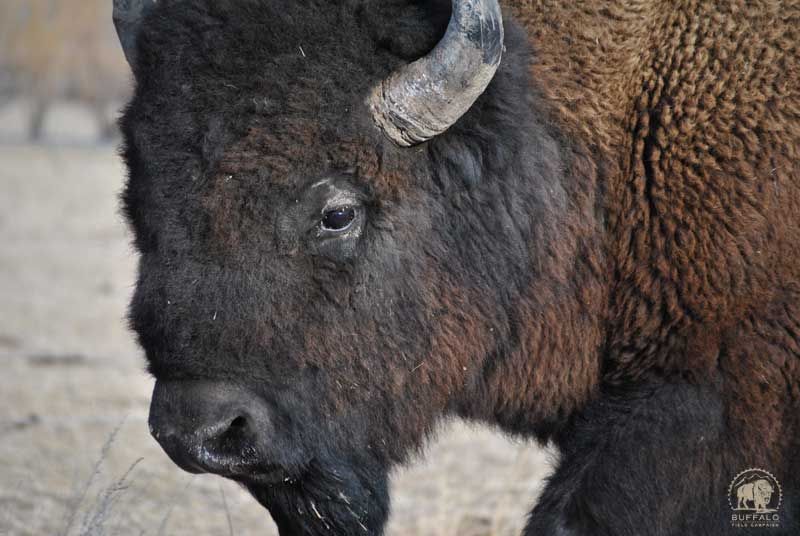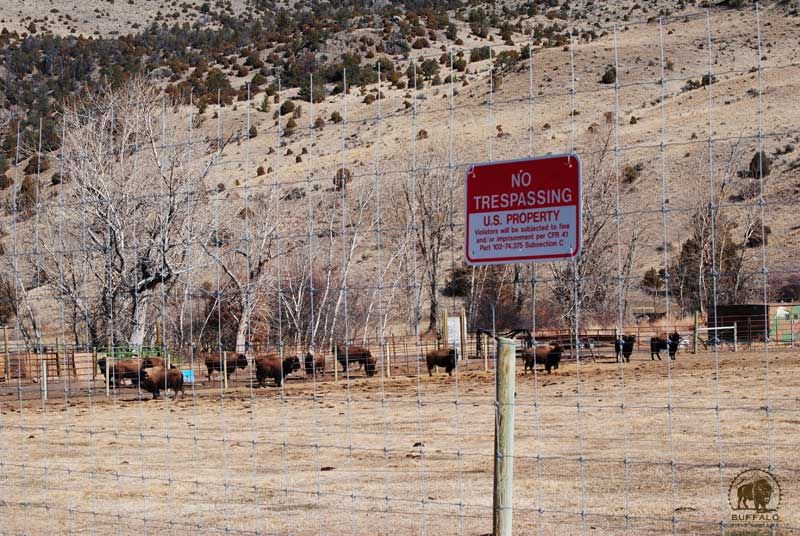Here at Buffalo Field Campaign, we spend a great deal of time and energy defending buffalo and seeking to eliminate the root causes of their problems. After standing with them for more than 20 years, we have a very good understanding of where their problems originate.
In short, the answer is this: All of the problems facing the last wild buffalo stem from “modern” human perceptions and behaviors. We are the cause. We have been from the beginning. Our species has created the current problems and circumstances that are destroying the buffalo. Period.
Many of the rules and laws enforced in and around Yellowstone National Park (YNP) are intended to assure that various species’ essential habitat needs are met and that long-term habitat protections for those species are in place…that is the theory anyway. For the buffalo, these mechanisms have proven grossly inadequate—and even counter-productive.

A wild buffalo. Yellowstone’s wild buffalo herds are under serious threat, including from regular hazing and quarantine procedures.
Unexpected Activities in a National Park
Within the boundaries of YNP, “buffalo management” activities include the hazing, capture, and shipping to slaughter of the few remaining wild buffalo.
Unfortunately, as part of a court-mediated settlement in 2000, the Secretaries of Agriculture and Interior and the Governor of Montana signed an agreement limiting buffalo numbers and habitat areas in Yellowstone and Montana. The settlement authorizes enforcement of the agreed-to numbers and boundaries through the killing of buffalo that venture near the park boundaries.
These actions are paid for with United States tax dollars and carried out by the National Park Service, Montana Department of Livestock, and other state and federal agencies. Obviously, these misguided activities impact sub-populations in many negative ways and are preventing Yellowstone buffalo from moving out of the park into important winter feeding areas that they have long used. These activities also harm many other species in the region.

Government agents (circled) use US tax dollars to haze buffalo down a steep, loose incline. How many babies can you count?
More Federal Forces
The United States Forest Service administers most of the public land outside YNP that buffalo have historically used as habitat. Displaying a deep lack of bio-logic, neither Forest Service Region 1 (Montana and Idaho) nor Region 2 (Wyoming) consider buffalo to be a species of conservation concern, despite buffalo being:
- Extremely rare in both local Forest Service regions;
- Designated “Near Threatened” on the International Union for Conservation of Nature (IUCN) Red List;
- A species of long-standing national interest and historical significance;
- A subject of great controversy;
- And clearly impacted by agency actions, such as the issuance of livestock grazing permits and other activities in what has been buffalo habitat for thousands of years.
It is also important to note that state wildlife officials in Montana and Idaho have lost most of their jurisdiction over wild buffalo, and those powers were transferred to their “livestock management” counterparts in other agencies, who now treat these buffalo as diseased domestic livestock instead of the last few members of a majestic, rare, and ecologically important population.
Quarantine: An Unnatural Selection
As if hazing, killing, and other “management” practices are not already bad enough, in 2016 Yellowstone National Park announced plans to create a permanent “operational” quarantine program for America’s only continuously wild population of bison, the Yellowstone herds. This announcement followed the (failed) quarantine feasibility study that began in 2005 and resulted in the removal of more than 200 wild bison from their native Yellowstone habitat; the majority of these animals were killed. All of the rest were domesticated—a life sentence for our national mammal.
Some of the quarantined bison endured years of “feasibility study” only to die from traumatic injuries suffered during transport or on their new pastures. Ten bison, including two calves, burned to death after their enclosure prevented them from escaping a grass fire in 2012. Another 19 died of thirst in 2015 after a water pump stopped functioning. This program represents not only poor management practices and a waste of US tax dollars; it is also inhumane and cruel.
This quarantine is based on the false premise that bison pose a risk of transmitting brucellosis to livestock. Objective science tells us that wild bison have never transmitted the livestock disease to cattle, while elk–far more prevalent in the ecosystem than bison–have transmitted the disease on numerous occasions. To accept this quarantine program as valid is to accept the brucellosis myth and to buy into the livestock industry’s insistence that wild bison should be slaughtered when they approach Yellowstone’s boundaries.
Yellowstone claims that quarantine saves wild bison from slaughter. Under this logic, which falsely presupposes that slaughtering wild bison is necessary, Yellowstone serves as both executioner and savior, deciding to slaughter wild buffalo on one hand while saving them from slaughter (through quarantine) on the other. All reasonable assessments of this situation prove the absurdity of current methods, yet the mindless slaughter continues.
Highly invasive and completely unnecessary, the buffalo quarantine removes bison calves from their family groups, confines them in fenced pastures where they are fed hay, and subjects them to invasive “livestock management practices” for two to four years. We know that approximately half of all quarantined buffalo are slaughtered during the process, and any survivors are loaded into livestock trailers and transported to fenced pastures where they live out the remainder of their lives. This is no life for a living national treasure and our national mammal.
Join Buffalo Field Campaign on the frontlines of Yellowstone via this immersive, informative, and entertaining short documentary produced by Thia Martin of Redshoes Studio.
Featured image: a herd of buffalo are hazed, as is routine in and around Yellowstone National Park. This process is highly stressful to buffalo and can be fatal, especially to vulnerable calves. This image and all images in this story credited to Buffalo Field Campaign.






